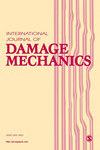深矿区干燥和水饱和白云岩的能量和破坏演化实验研究
IF 3.9
2区 工程技术
Q2 MATERIALS SCIENCE, MULTIDISCIPLINARY
引用次数: 0
摘要
岩石的变形和破坏与岩石受载过程中的应变能消耗密切相关。为了研究水对深部矿山白云岩样品能量演化和破坏特征的影响,对不同埋深(900 米-1200 米)的干燥和水饱和白云岩样品进行了单轴压缩试验。分析了岩石变形和破坏过程中水对弹性能和耗散能比(Ue/ U 和 Ud/U)演变特征的影响。根据损伤因子(Df)的变化率,提出了一种新的脆性指数,该指数可有效表征含水白云岩的脆性特征。结果表明,与干燥样品相比,饱水白云岩的单轴抗压强度和弹性模量明显降低。白云岩的能量和损伤演化过程可分为四个阶段:初始损伤阶段、稳定损伤阶段、峰前加速损伤阶段和损伤后阶段。经饱和水处理后,岩石样品在稳定破坏阶段和峰值前加速破坏阶段的破坏因子变化率明显增加。与水饱和样品相比,干燥样品的能量硬化特征和脆性特征更为明显。此外,还分析了水导致岩石力学性能和储能性能恶化后对深层岩石工程稳定性可能产生的影响。地下水可以在一定程度上降低岩石的易爆裂性。但是,地下水也有可能导致岩石工程失稳和破坏的危险。本文章由计算机程序翻译,如有差异,请以英文原文为准。
Experimental study on energy and damage evolution of dry and water-saturated dolomite from a deep mine
The deformation and failure of a rock is closely related to the strain energy consumption during the load process of rock. To investigate the effect of water on energy evolution and damage characteristics of dolomite samples from a deep mine, the uniaxial compression tests were carried out on dry and water-saturated dolomite samples at different burial depths (900 m–1200 m). The effects of water on the evolution characteristics of elastic and dissipative energy ratios ( Ue / U and Ud / U) during rock deformation and failure was analyzed. Based on the variation rate of damage factor ( Df ), a new brittleness index is proposed, which can effectively characterize the brittleness characteristics of water-bearing dolomite. The results show that the uniaxial compressive strength and elastic modulus of the water-saturated dolomite are significantly reduced compared to dry sample. The energy and damage evolution process of dolomite can be divided into four stages: initial damage stage, stable damage stage, pre-peak accelerated damage stage and post-damage stage. The variation rate of damage factor of the rock samples in the stable damage stage and the pre-peak accelerated damage stage appeared to increase significantly after water saturation treatment. Compared with water-saturated samples, more pronounced energy hardening characteristics and brittleness characteristics were observed in dry samples. In addition, the possible impact on the stability of deep rock engineering after the deterioration of rock mechanical properties and energy storage properties caused by water was analyzed. Groundwater can somewhat reduce rock burst proneness. However, it also has the potential to lead to greater rock engineering destabilization and failure hazards.
求助全文
通过发布文献求助,成功后即可免费获取论文全文。
去求助
来源期刊

International Journal of Damage Mechanics
工程技术-材料科学:综合
CiteScore
8.70
自引率
26.20%
发文量
48
审稿时长
5.4 months
期刊介绍:
Featuring original, peer-reviewed papers by leading specialists from around the world, the International Journal of Damage Mechanics covers new developments in the science and engineering of fracture and damage mechanics.
Devoted to the prompt publication of original papers reporting the results of experimental or theoretical work on any aspect of research in the mechanics of fracture and damage assessment, the journal provides an effective mechanism to disseminate information not only within the research community but also between the reseach laboratory and industrial design department.
The journal also promotes and contributes to development of the concept of damage mechanics. This journal is a member of the Committee on Publication Ethics (COPE).
 求助内容:
求助内容: 应助结果提醒方式:
应助结果提醒方式:


